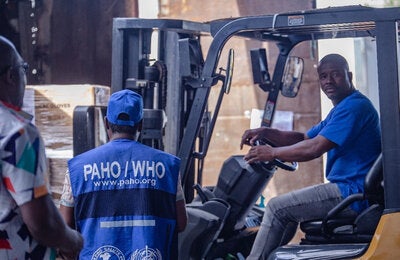Washington, D.C., December 10, 2008 (PAHO)—The Internet and the rise of "virtual worlds" are opening up new, unparalleled opportunities for expanding dissemination of and access to public health information, experts said in a panel discussion on new information technologies at the Pan American Health Organization (PAHO) this week.
The growing phenomenon of virtual worlds—in which multiple Internet users interact in simulated environments—is creating new models for multidisciplinary collaboration that will become dominant in the near future, said Victor Cid, senior computer scientist at the Disaster Information Research Center of the National Library of Medicine.
"Millions of people around the world today spend many hours every day learning, playing, and doing business in virtual worlds," said Cid. "The availability of more powerful computers and networks, as well as advances in computer gaming, are giving new life to the old vision of a 3-D Internet that is being enabled by virtual worlds such as Second Life."
Second Life is the virtual world launched by Linden Lab in 2003, in which users interact with one another through avatars, carrying on virtual lives and building virtual communities.
Industry experts (Gartner, Inc., 2007) estimate that 80 percent of active Internet users will be participating in virtual worlds by the end of 2011, said Cid. Already, they have attracted a rapidly growing number of individuals, organizations, and businesses that use them on a daily basis. Second Life is only one of many such virtual worlds, Cid noted, recommending the web page www.virtualworldsreview.com as a source that lists virtual worlds that currently receive the most traffic.
José Francisco Salm, of the Stela Institute in Brazil, presented some of the complexities of constructing and developing virtual worlds, but emphasized their great potential as a tool for searching and accessing quality information in cyberspace.
Participants in the panel, organized by PAHO's Knowledge Management and Communications Area (KMC), called for more study of the potential, problems, limitations, and challenges of using virtual worlds to maximize information dissemination and virtual collaboration in public health.
"This event is one additional complement to all our projects and strategies for disseminating information to all our audiences," said Marcelo D'Agostino, PAHO regional advisor on knowledge management, at the close of the session. He urged stepped-up efforts to eliminate gaps in access to public health information because "independently of technology infrastructure, we must reach all of our audiences in the Americas."
The Pan American Health Organization, founded in 1902, works with all the countries of the Americas to improve the health and quality of life of their peoples. It serves as the Regional Office of the World Health Organization (WHO).
For more information please contact Donna Eberwine-Villagrán, Public Information, Knowledge Management and Communication, tel (202) 974-3122, fax (202) 974-3143.



